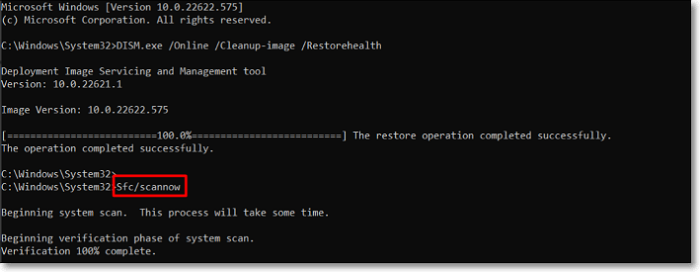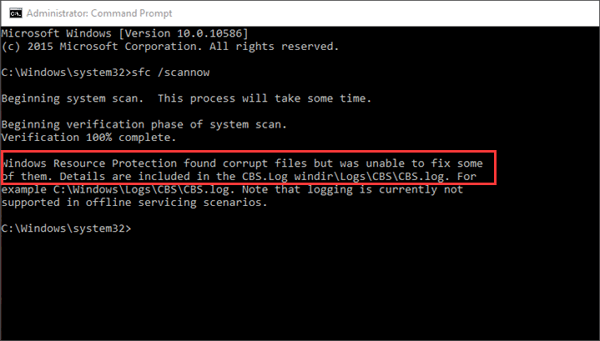What Is SFC Scannow Command
SFC Scannow command is a built-in utility that lets you scan for corrupted files on your Windows system and automatically repair them. This command scans all the Windows system files, including DLL files, which are the most integral files of Windows. It works on replacing incorrect, corrupted, changed, or damaged system files with the cached version of the files. The SFC Scan command automatically modifies the Windows system files and settings, including DLL files, to resolve the issue.
If it finds issues with the system settings, it restores the particular setting by returning it to the default. The System File Checker Scannow command is one of the best commands to troubleshoot all Windows-related errors with ease.
Another possible reason could be that most Windows errors occur because of corrupted system files. Even if the SFC Scannow command doesn't find any damaged files, it automatically ends up fixing other Windows-related errors that are expected to cause any inconvenience now or in the future.
SFC Scannow command is a great way to ensure all your Windows system files are perfect, even if you haven't started facing any issues. You can run the System File Checker Scannow command on any Windows PC.
You need to access the Command Prompt with administrative rights to execute the SFC Scannow command. In case the scan finds some violations in the system files, you can check all the corrupted files in the CBS.log File.
Read the next section to run the SFC Scannow command on your Windows PC.
How to Run SFC Scannow Command on Windows?
You can simply use the SFC Scannow command if your Windows functions aren't working properly. Follow the below-mentioned steps to run the SFC Scannow command on your Windows system.
Step 1. Press the Windows key on your keyboard to get the Windows Search Bar.
Step 2. Type Command Prompt in the Search Bar.

Step 3. Click on "Run as administrator".

Step 4. Type the mentioned command in the Command Prompt:
DISM.exe /Online /Cleanup-image /Restorehealth
Step 5. You can now see the DISM scan progress in the Command Prompt.

Step 6. Once the scan is completed, you will see a scan completion message:
The restore operation completed successfully. The operation completed successfully.

Step 7. Execute the System File Checker Scannow command in the same Command Prompt window.
sfc /scannow

Step 8. You will now see that the SFC Scan is in progress. Wait until the verification is completed. If the command doesn't work, read this guide below on how to fix it.
Fixed: SFC (SFC / SCANNOW) Is Not Working on Windows
According to Microsoft Windows Support, SFC, also called System File Checker, is a utility in Windows that allows users to scan for corruptions in Windows system files and restore corrupted files.

Step 9. Once the scan is completed, you will be shown one of the below-mentioned messages.
Windows Resource Protection did not find any integrity violations.
Windows Resource Protection could not perform the requested operation.
Windows Resource Protection found corrupt files and successfully repaired them. Details are included in the CBS.Log %WinDir%\Logs\CBS\CBS.log.

In case the scan shows Windows Resource Protection could not perform the requested operation completion message. You need to boot your PC into Safe Mode and execute the same SFC Scannow command. Once everything is done, you can view the System File Checker scan logs in the PendingDeletes and PendingRenames folders under the %WinDir%\WinSxS\Temp location.
How Do I Fix Corrupted Files with SFC Scannow?
You can now simply use the System File Checker Scan now command to repair your Windows system's corrupted files. We have explained the complete process of executing the SFC Command in the below-mentioned steps.
Step 1. Right-click on the "Windows icon" and select Terminal (Admin) from the given options.

Step 2. Copy and paste the mentioned command in the Terminal.
sfc /scannow

Step 3. Let the verification phase start and complete. You can also check the progress of the scan on the same window.
Step 4. Once done, close the console and reboot the system.
Is SFC Scannow Good to Run?
Running the System File Checker Scannow command is really beneficial for the system but to some extent only.
You need to remember that executing the SFC Scannow command can change the settings and set them back to the default state. Notably, modifying the system files could be risky unless you are technically sound about Windows. Otherwise, it can lead to many issues and ruin the entire user experience if you don't execute it properly.
We recommend taking a backup of your Windows system before running the System File Checker Scannow command. This is a little drawback of the SFC Scannow command.
Running SFC Scannow isn't a bad idea. But, running it more frequently, like every day, won't make any change to the system. Running it every day would be a waste of your time and computer resources. You can run the SFC Scannow command once a month.
We hope you must have got enough information about the SFC Scannow command. It's pretty easy to use the System File Checker tool, and you can follow the above-mentioned methods to do the same with ease.
Was This Page Helpful?
Daisy is the Senior editor of the writing team for EaseUS. She has been working at EaseUS for over ten years, starting as a technical writer and moving on to being a team leader of the content group. As a professional author for over ten years, she writes a lot to help people overcome their tech troubles.
Related Articles
-
What Is VSync and When Should You Turn it On? [Full Information]
 Daisy/2024-01-11
Daisy/2024-01-11 -
Windows 11 Download: How to Download and Install Windows 11 [3 Ways]
 Cedric/2024-10-25
Cedric/2024-10-25 -
New Windows 11 Known Issues Keep Coming | How to Fix Known Issues in Windows 11
 Tracy King/2024-10-25
Tracy King/2024-10-25 -
Plist File on Windows: What Is It and How To Open It? [2024 HOT]
 Tracy King/2024-01-11
Tracy King/2024-01-11
